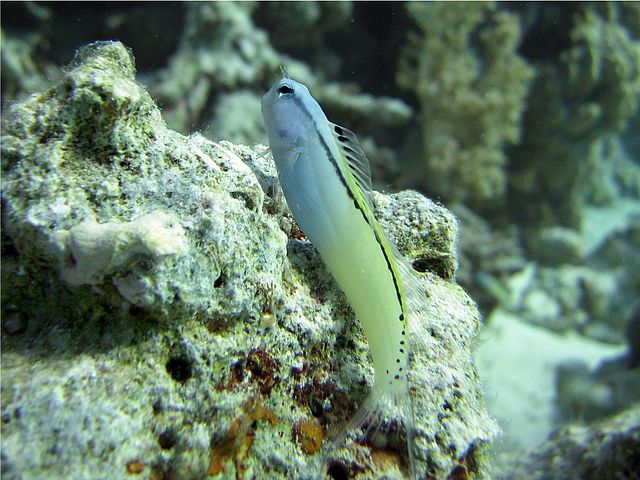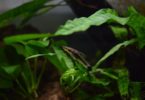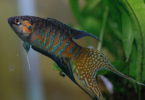Last Updated on February 10, 2023 by Matt
The Red Sea Mimic Blenny, Ecsenius gravieri, is a spectacular mid-sized blenny that has an amazing coloration drawn from truly interesting behavior.
Having this stunning little fish in your aquarium introduces a dash of color, an unusual benthic fish, and a real talking point.
In this article we will give a description of the Red Sea Mimic Blenny, its distribution, behavior and diet, and compatibility in the aquarium.
IN THIS ARTICLE
Quick Red Sea Mimic Blenny Care Sheet
| Red Sea Mimic Blenny Summary | |
| Care Level | Easy |
| Family | Blenniidae, subfamily Salarinae |
| Temperament | Peaceful |
| Diet | Herbivorous |
| Origin | Red Sea |
| Minimum Tank Size | 10 gallons |
| Color | Yellow, Green, Blue, Black |
| Size | 3 inches |
| Reef Compatible? | Yes |
| Temperature | 72-78°F |
| Carbonate Hardness | 8-12 dKH |
| Specific Gravity | 1.020-1.025 |
| pH Range | 8.1-8.4 |
Description and Distribution

Photo Credit: Alain Feulvarch (Flickr)
Ecsenius gravieri is a Clown blenny of the Ecsenius genus. It is part of the Salarinae subfamily of the Blenniidae family, and part of the order Blenniiformes. The Red Sea Mimic Blenny is endemic to the Red Sea, as the name suggests. It is found throughout the Red Sea, from the Gulf of Aqaba to the westernmost Gulf of Aden.
The Red Sea Mimic Blenny is a mid sized clown blenny, reaching 3 inches in length. The body has a gradiented coloration, being blue/green at the head and anterior body before becoming yellow in the mid-posterior body. Line of black markings run from the eye down the lateral line under the dorsal fin to the tail.
This coloration is a classic example of Batesian mimicry. Batesian mimicry is where a harmless species has evolved the same coloration and warning signs as a venomous, poisonous, or otherwise harmful species which are directed at a predator of them both.
The coloration of the Red Sea Mimic Blenny is designed to mimic that of the blenny Meiacanthus nigrolineatus, which has venomous fangs it uses to bite the cheeks of predators that try to ingest it. Would-be predators quickly spit it out and learn to stay away.
By mimicking the coloration of this venomous blenny, E. gravieri is protected from potential predators as they associate the coloration with a not very nice meal!
Behavior and Diet
In general, the Red Sea Mimic Blenny is a peaceful fish and will simply go about its own business in the tank.
They are benthic fish, seen resting and hiding amongst the rocks, holes, and crevices of your reef tank. All Clown Blennies lack a swim bladder, much like sharks. As such, they are negatively buoyant and sink to the substrate, unless they continuously move their pectoral fins in order to hold themselves in place in the water column.
Therefore they spend the majority of their time on the substrate, normally the hard rock that they call home, and are never far from their favored hiding place. When startled they will enter their hole with their head sticking out so they can scout the area. They will emerge when they deem the coast is clear.
While the Red Sea Mimic Blenny is peaceful, they do hold a small territory and will defend it, especially from conspecifics. These territorial battles are normally ritualized, with aggressive territorial displays but no physical contact. If no blenny backs down then fighting will occur; biting of the head a neck area and locking jaws. Unless space is at an absolute premium serious injuries are unlikely to occur; multiple blennies are often seen on the same coral head.
Most likely is that the Red Sea Mimic Blenny is on the receiving end of rough treatment. Benthic fish such as Hawkfish and larger Blenny species are known to be aggressive towards the smaller blenny species.
E. gravieri is herbivorous, scraping algae off of the hard rock surface. However they have been known to nip at small polyp stony corals. You should allow growth of algae in the tank to give them a natural source of food, but their diet will also need to be supplemented.
Their diet should include dried seaweed, frozen foods rich in vegetable matter, and also a high quality basic pelleted or flaked food. Foods high in the blue-green algae spirulina should be provided, such as Omega One Sinking Pellets. Watch the size of your blenny carefully, as they may need feeding twice or three times a day.
Compatibility and Tank Mates
Red Sea Mimic Blennies are reef safe; they are herbivorous so won’t attach invertebrates or fry. However be wary of having small polyp stony coral in the tank, as they are known to nip them.
All clown blennies need many places to hide, in order to emulate the natural habitat as closely as possible. Drilling small appropriately sized holes into the live rock to give the blenny many possible hiding places is highly recommended.
They need a minimum of a 10 gallon tank, but this is the bare minimum. It is recommended to have a larger tank for them. In a 10 gallon tank their diet will need to be supplemented quite heavily, as there won’t be enough algal growth.
In terms of water conditions, they need a temperature range of 72-78°F, a carbonate hardness of 8-12 dKH, a pH range of 8.1-8.4 and a specific gravity of 1.020-1.025. An aquarium heater, thermometer, filter, and protein skimmer are essential. Regular water changes are needed to ensure water chemistry. The Python water changer can aid in this.
As they can be territorial between conspecifics, more than one shouldn’t be kept in the tank unless there is enough space for two fish to have many hiding places and their own territory. Breeding pairs are an exception to this; they can be housed together without any issues.
The Red Sea Mimic Blenny can be housed with many species of marine reef fish without incident or problems. The only issue lies with other benthic fish such as the Hawkfish and larger Blennies. As they inhabit the same space in the tank they will be aggressive towards the smaller Red Sea Mimic Blenny.
Conclusion
Hopefully this Red Sea Mimic Blenny care guide article has been informative and useful.
E. gravieri is a beautiful fish, appropriate for saltwater reef tanks of 10 gallons or more. They have a stunning coloraation, evolved to mimic that of the venomous blenny Meiacanthus nigrolineatus. Having this blenny in your tank gives you a piece of this amazing natural history right in your home aquarium.
Featured Image Photo Credit: Alain Feulvarch (Flickr)







